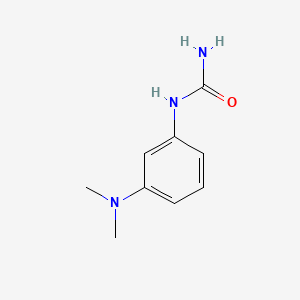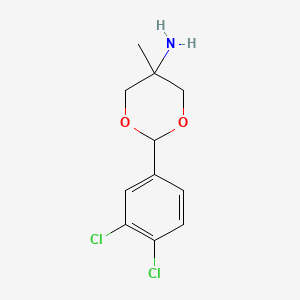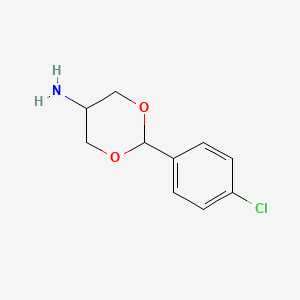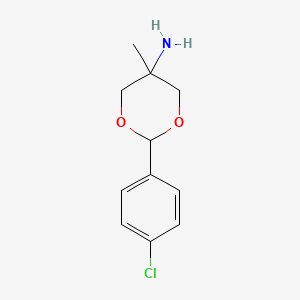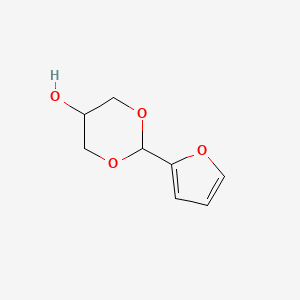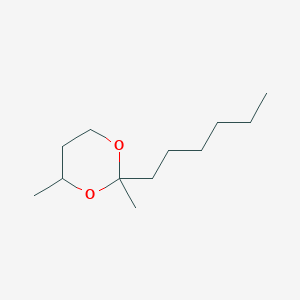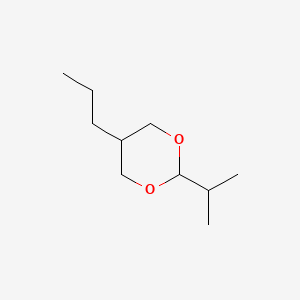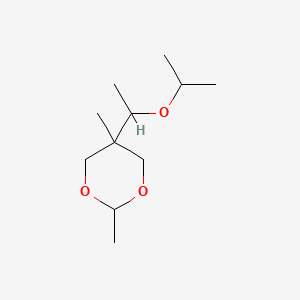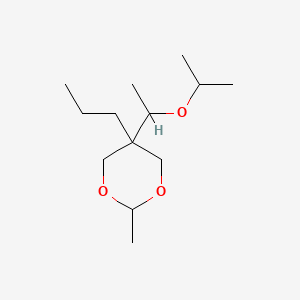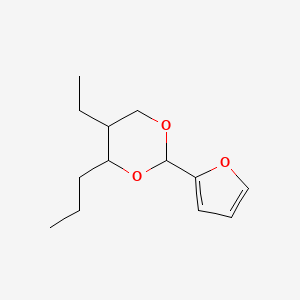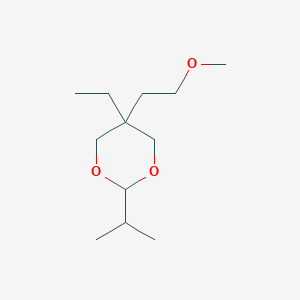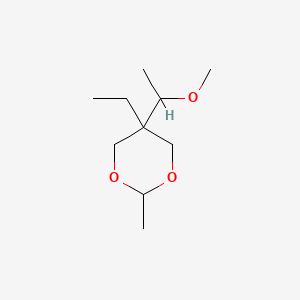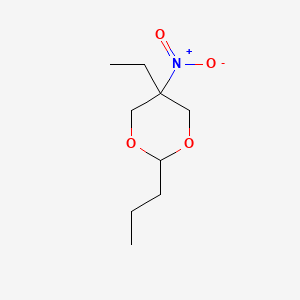
Maraviroc
Übersicht
Beschreibung
Maraviroc ist ein Chemokinrezeptor-Antagonist, der von Pfizer entwickelt und unter den Markennamen Selzentry in den Vereinigten Staaten und Celsentri in der Europäischen Union vermarktet wird . Es wird hauptsächlich als antiretrovirales Medikament zur Behandlung von CCR5-tropen HIV-1-Infektionen eingesetzt . This compound wirkt, indem es den CCR5-Rezeptor auf der Oberfläche bestimmter menschlicher Zellen blockiert und so verhindert, dass das HIV-Virus in diese Zellen eindringen kann .
Wirkmechanismus
Target of Action
Maraviroc, developed by Pfizer, is a chemokine receptor antagonist drug . Its primary target is the human chemokine receptor CCR5 . This receptor is present on the membrane of CD4 cells (T-cells), which are a type of white blood cell that plays a key role in the immune system .
Mode of Action
This compound works by blocking HIV from entering human cells . Specifically, it is a selective, slowly reversible, small molecule antagonist of the interaction between human CCR5 and HIV-1 gp120 . By binding to CCR5, this compound prevents the interaction of HIV-1 gp120 with CCR5-tropic HIV-1, thereby inhibiting the virus from entering the cell .
Biochemical Pathways
This compound’s action affects the HIV entry process . The drug interferes with the interaction between the HIV-1 gp120 protein and the CCR5 receptor, which is an essential step for the virus to enter the host cell . By blocking this interaction, this compound prevents the virus from fusing with the human cell membrane .
Pharmacokinetics
This compound is extensively metabolized by CYP3A4 , with renal clearance accounting for approximately 23% of total clearance . The half-life of this compound is approximately 16 hours .
Result of Action
The molecular and cellular effects of this compound’s action result in the inhibition of HIV-1 entry into human cells . By preventing the virus from entering the cells, this compound can effectively reduce the progression of HIV-1 infection .
Action Environment
The efficacy and stability of this compound can be influenced by various environmental factors. For instance, the sensitivity of tropism testing can impact the treatment outcome of this compound-containing regimens . Additionally, this compound’s exposure is altered by agents that modulate the activity of CYP3A4, and in some circumstances, this compound dose adjustment is necessary .
Wissenschaftliche Forschungsanwendungen
Maraviroc hat eine große Bandbreite an Anwendungen in der wissenschaftlichen Forschung:
Medizin: Klinisch wird this compound in Kombination mit anderen antiretroviralen Mitteln zur Behandlung von HIV-1-Infektionen eingesetzt.
Wirkmechanismus
This compound wirkt als Eintrittshemmer, indem es selektiv an den CCR5-Rezeptor auf der Oberfläche menschlicher Zellen bindet . Diese Bindung verhindert, dass das HIV-1-gp120-Protein mit dem CCR5-Rezeptor assoziiert, wodurch das Virus daran gehindert wird, in die Wirtszelle einzudringen . Das Medikament wirkt als negativer allosterischer Modulator des CCR5-Rezeptors und induziert eine Konformationsänderung, die die Wechselwirkung zwischen Rezeptor und Virus hemmt .
Biochemische Analyse
Biochemical Properties
Maraviroc selectively binds to the human chemokine receptor CCR5 present on the membrane of CD4 cells (T-cells), preventing the interaction of HIV-1 gp120 and CCR5 necessary for CCR5-tropic HIV-1 to enter cells . This interaction is crucial for the biochemical reactions involving this compound.
Cellular Effects
This compound, by binding to CCR5, blocks HIV from entering human cells . This influences cell function by preventing the virus from integrating into the host genome, thus preventing the production of new viral particles. This has a significant impact on cell signaling pathways, gene expression, and cellular metabolism.
Molecular Mechanism
This compound is an entry inhibitor and works by blocking HIV from entering human cells . Specifically, this compound is a selective, slowly reversible, small molecule antagonist of the interaction between human CCR5 and HIV-1 gp120 . This prevents the virus from fusing with the human cell membrane .
Temporal Effects in Laboratory Settings
The effects of this compound have been studied over time in laboratory settings. This compound is extensively metabolized by CYP3A4, with renal clearance accounting for approximately 23% of total clearance . The half-life of this compound is approximately 16 hours .
Metabolic Pathways
This compound is extensively metabolized by CYP3A4 . This enzyme plays a crucial role in the metabolic pathway of this compound. The major metabolic pathways of this compound involve oxidation and N-dealkylation .
Transport and Distribution
This compound does not inhibit any of the three studied ABC transporters, and its permeability is not affected by ABCG2 or ABCC2 . This compound shows affinity for human ABCB1 and the endogenous canine Abcb1 expressed in MDCKII cells . This suggests that ABCB1/Abcb1 facilitate in situ this compound transport .
Vorbereitungsmethoden
Maraviroc kann mit verschiedenen Verfahren synthetisiert werden. Dieses Verfahren beinhaltet die direkte Alkylierung eines Amins mit einem Alkohol unter technologisch akzeptablen Bedingungen . Der Prozess beinhaltet verbesserte Isolations- und Reinigungsschritte, um hochreines this compound zu erhalten . Industrielle Produktionsverfahren folgen in der Regel ähnlichen Synthesewegen, werden aber für die großtechnische Produktion optimiert, um Konsistenz und Effizienz zu gewährleisten .
Analyse Chemischer Reaktionen
Maraviroc durchläuft verschiedene Arten chemischer Reaktionen, darunter:
Oxidation: this compound kann unter bestimmten Bedingungen oxidiert werden, was zur Bildung verschiedener Oxidationsprodukte führt.
Reduktion: Reduktionsreaktionen können die funktionellen Gruppen innerhalb von this compound modifizieren und so seine chemischen Eigenschaften verändern.
Substitution: This compound kann Substitutionsreaktionen eingehen, bei denen eine funktionelle Gruppe durch eine andere ersetzt wird. Häufige Reagenzien, die in diesen Reaktionen verwendet werden, sind Oxidationsmittel, Reduktionsmittel und verschiedene Katalysatoren.
Vergleich Mit ähnlichen Verbindungen
Maraviroc ist unter den antiretroviralen Mitteln einzigartig, da es einen menschlichen Rezeptor anstelle des Virus selbst angreift . Ähnliche Verbindungen umfassen andere CCR5-Antagonisten, wie zum Beispiel:
Vicriviroc: Ein weiterer CCR5-Antagonist mit ähnlichen Wirkmechanismen, aber unterschiedlichen pharmakokinetischen Eigenschaften.
Eigenschaften
IUPAC Name |
4,4-difluoro-N-[3-[3-(3-methyl-5-propan-2-yl-1,2,4-triazol-4-yl)-8-azabicyclo[3.2.1]octan-8-yl]-1-phenylpropyl]cyclohexane-1-carboxamide | |
|---|---|---|
| Details | Computed by Lexichem TK 2.7.0 (PubChem release 2021.05.07) | |
| Source | PubChem | |
| URL | https://pubchem.ncbi.nlm.nih.gov | |
| Description | Data deposited in or computed by PubChem | |
InChI |
InChI=1S/C29H41F2N5O/c1-19(2)27-34-33-20(3)36(27)25-17-23-9-10-24(18-25)35(23)16-13-26(21-7-5-4-6-8-21)32-28(37)22-11-14-29(30,31)15-12-22/h4-8,19,22-26H,9-18H2,1-3H3,(H,32,37) | |
| Details | Computed by InChI 1.0.6 (PubChem release 2021.05.07) | |
| Source | PubChem | |
| URL | https://pubchem.ncbi.nlm.nih.gov | |
| Description | Data deposited in or computed by PubChem | |
InChI Key |
GSNHKUDZZFZSJB-UHFFFAOYSA-N | |
| Details | Computed by InChI 1.0.6 (PubChem release 2021.05.07) | |
| Source | PubChem | |
| URL | https://pubchem.ncbi.nlm.nih.gov | |
| Description | Data deposited in or computed by PubChem | |
Canonical SMILES |
CC1=NN=C(N1C2CC3CCC(C2)N3CCC(C4=CC=CC=C4)NC(=O)C5CCC(CC5)(F)F)C(C)C | |
| Details | Computed by OEChem 2.3.0 (PubChem release 2021.05.07) | |
| Source | PubChem | |
| URL | https://pubchem.ncbi.nlm.nih.gov | |
| Description | Data deposited in or computed by PubChem | |
Molecular Formula |
C29H41F2N5O | |
| Details | Computed by PubChem 2.1 (PubChem release 2021.05.07) | |
| Source | PubChem | |
| URL | https://pubchem.ncbi.nlm.nih.gov | |
| Description | Data deposited in or computed by PubChem | |
Molecular Weight |
513.7 g/mol | |
| Details | Computed by PubChem 2.1 (PubChem release 2021.05.07) | |
| Source | PubChem | |
| URL | https://pubchem.ncbi.nlm.nih.gov | |
| Description | Data deposited in or computed by PubChem | |
Retrosynthesis Analysis
AI-Powered Synthesis Planning: Our tool employs the Template_relevance Pistachio, Template_relevance Bkms_metabolic, Template_relevance Pistachio_ringbreaker, Template_relevance Reaxys, Template_relevance Reaxys_biocatalysis model, leveraging a vast database of chemical reactions to predict feasible synthetic routes.
One-Step Synthesis Focus: Specifically designed for one-step synthesis, it provides concise and direct routes for your target compounds, streamlining the synthesis process.
Accurate Predictions: Utilizing the extensive PISTACHIO, BKMS_METABOLIC, PISTACHIO_RINGBREAKER, REAXYS, REAXYS_BIOCATALYSIS database, our tool offers high-accuracy predictions, reflecting the latest in chemical research and data.
Strategy Settings
| Precursor scoring | Relevance Heuristic |
|---|---|
| Min. plausibility | 0.01 |
| Model | Template_relevance |
| Template Set | Pistachio/Bkms_metabolic/Pistachio_ringbreaker/Reaxys/Reaxys_biocatalysis |
| Top-N result to add to graph | 6 |
Feasible Synthetic Routes
Haftungsausschluss und Informationen zu In-Vitro-Forschungsprodukten
Bitte beachten Sie, dass alle Artikel und Produktinformationen, die auf BenchChem präsentiert werden, ausschließlich zu Informationszwecken bestimmt sind. Die auf BenchChem zum Kauf angebotenen Produkte sind speziell für In-vitro-Studien konzipiert, die außerhalb lebender Organismen durchgeführt werden. In-vitro-Studien, abgeleitet von dem lateinischen Begriff "in Glas", beinhalten Experimente, die in kontrollierten Laborumgebungen unter Verwendung von Zellen oder Geweben durchgeführt werden. Es ist wichtig zu beachten, dass diese Produkte nicht als Arzneimittel oder Medikamente eingestuft sind und keine Zulassung der FDA für die Vorbeugung, Behandlung oder Heilung von medizinischen Zuständen, Beschwerden oder Krankheiten erhalten haben. Wir müssen betonen, dass jede Form der körperlichen Einführung dieser Produkte in Menschen oder Tiere gesetzlich strikt untersagt ist. Es ist unerlässlich, sich an diese Richtlinien zu halten, um die Einhaltung rechtlicher und ethischer Standards in Forschung und Experiment zu gewährleisten.


